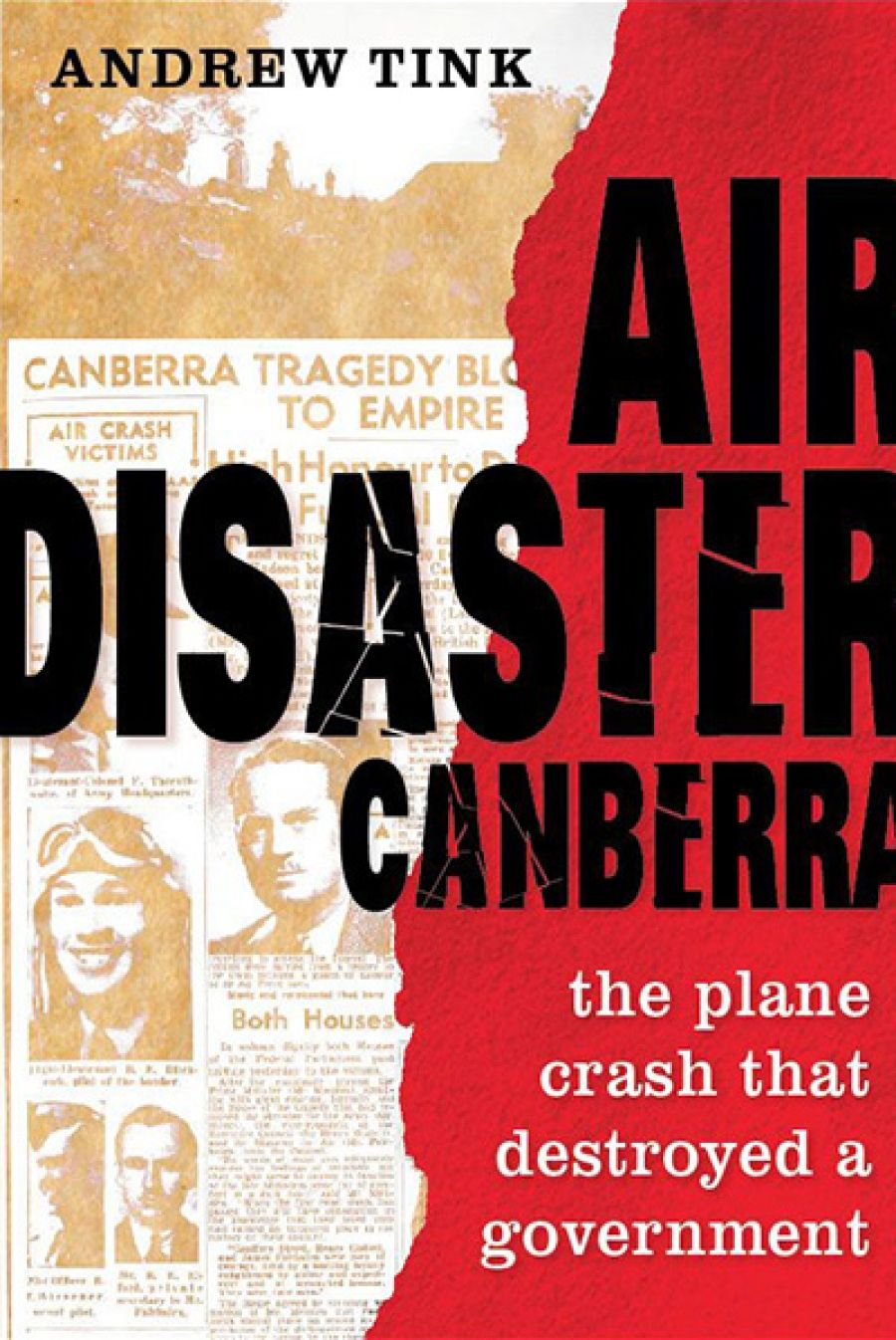
- Free Article: No
- Contents Category: Australian History
- Custom Article Title: Lyndon Megarrity reviews 'Air Disaster Canberra'
- Review Article: Yes
- Article Title: The crash
- Online Only: No
- Custom Highlight Text:
On 13 August 1940 a Hudson Bomber travelling from Melbourne crashed near Canberra, killing all ten people on board. Three of the deceased were federal ministers: Geoffrey Street (army minister), Sir Henry S. Gullett (vice-president of the Executive Council), and James Fairbairn (minister for air and civil aviation). Also on board that day was Cyril Brudenell Bingham White, a senior Army officer (chief of the general staff).
- Book 1 Title: Air Disaster Canberra
- Book 1 Subtitle: The plane crash that destroyed a government
- Book 1 Biblio: NewSouth, $45 hb, 335 pp
The sudden loss of his ministers was a severe blow to Prime Minister Robert Menzies; they were personal friends as well as his political allies. ‘I shall never forget that terrible hour,’ he later wrote in Afternoon Light (1967), ‘I felt for me the end of the world had come.’ As Andrew Tink’s new book reminds us, the 1940 air disaster also destabilised Menzies’ political grip on power, contributing to his downfall as prime minister in 1941.
Since leaving the New South Wales parliament, the author – a former shadow attorney-general – has developed a strong passion for Australian history. Arguably, Tink’s best-known publication so far is his biography of William Charles Wentworth (2009). Air Disaster Canberra, his latest effort, is an ambitious and at times controversial book that tries to do too many things in the one publication. Tink is at his best when fleshing out the main characters in this story, from the ministers to the flight crew. The author also skilfully highlights the continuing mysteries surrounding what happened on that fatal day, although the general reader may find the technical details regarding the Hudson plane somewhat perplexing. A glossary of aviation terms might have been helpful in this regard.
While frequently fascinating and easy to read, Tink’s narrative contains much unnecessary padding. For instance, instead of concentrating on his interpretation of the political impact of the air disaster, the author in Part 3 presents the reader with a lengthy political chronicle leading to Menzies’ resignation as prime minister. The supposed link with the overall theme of the work is often obscured. It is not clear by the end of the book how much we can attribute the toppling of the first Menzies government to the loss of key ministers in the Canberra air disaster and how much was due to other factors. Menzies’ poor relations with his own side of politics and his politically naïve decision to make an official visit to London for several months may have been more influential.
 The aftermath of the crash (National Archives of Australia)
The aftermath of the crash (National Archives of Australia)
Of course, it is impossible to quantify the loss of three serving ministers to a government. It was an era, as Tink notes, when lack of service in World War I could be used against a politician, as Menzies (who was twenty in 1914) found to his dismay. The unswerving political support of three Great War veterans like Street, Fairbairn, and Gullett was probably a psychological boost to Menzies on the eve of his prime ministership, when he was viciously attacked by Country Party leader Earle Page for not serving overseas.
One of the more intriguing aspects of the book is Tink’s exploration of the theory that the pilot on that fateful day in 1940 allowed the air minister, James Fairbairn – an enthusiastic aviator with a penchant for risk-taking – to take over the controls, thereby contributing to the accident because the latter was unfamiliar with operating the aircraft. From the evidence presented, it does seem plausible. Among other things, reports of the time suggest that Fairbairn was very eager to fly and master the Hudson bomber. Moreover, Bob Hitchcock, the designated pilot, had flown Hudsons without incident on several occasions, which creates doubt as to whether he was at the controls. Nevertheless, there is too much hearsay and not enough hard evidence to make a final judgement call on this issue.
The referencing and bibliography in this book are a little slapdash. At times the sources of quotes are obscured by the placement of multiple references in the one endnote. Further, the original publication dates for the Australian Dictionary of Biography entries that the author rather heavily relies on are frequently absent, thereby depriving the reader of necessary context and identification. In my view, ADB online and other e-resources should be referenced with the same care and eye for posterity as offline publications.
Selection of sources is also somewhat problematic. For instance, the author’s use of Paul Hasluck’s harsh, self-serving pen portraits of his political contemporaries is rather uncritical. A distinguished but often politically frustrated individual, Hasluck is not necessarily the best person from whom to seek the ‘last word’ on Arthur Fadden, R.G. Casey, or anyone else. Further, while Tink makes extensive use of archival records, and does so well, there are some serious gaps in his secondary sources. The absence of articles from journals such as the Australian Journal of Politics and History and Labour History is unfortunate, as they are likely to have exposed the author to new research possibilities and perspectives.
Air Disaster Canberra covers too much territory, but there is enough useful reflection on the historical context of 1930s and 1940s Australia to make it well worth reading. Most notably, the book will introduce many readers to the younger, more vulnerable Menzies. Andrew Tink joins a growing number of authors whose work is shedding new light on Menzies, the man and politician.


Comments powered by CComment